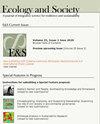中国生态阈值与可选稳定状态数据库:对世界相关研究的启示
IF 3.2
2区 社会学
Q1 ECOLOGY
引用次数: 0
摘要
提出了生态阈值和可选稳定状态的概念来解释非线性变化。然而,推动这些理论及其管理应用的最大障碍是缺乏数据和研究经验。中国的生态系统类型几乎齐全,20世纪末发生了各种生态退化和灾变事件。大量关注生态阈值的监测数据和研究案例以中文发表,限制了它们在世界范围内的传播。我们参考阈值数据库和制度转移数据库的框架整合了中国的案例和数据。本文介绍了由中国环境科学研究院开发的主要收集研究案例的中国生态阈值与可选稳定状态数据库(CETASSD)。CETASSD使用统一的描述框架来整合来自中国过去110个案例研究的关键信息。本文总结了与社会生态系统的生态阈值和可选稳定状态具有内在一致性的相关案例研究。我们整理和分析了CETASSD的26个潜在替代稳定状态和60个潜在生态阈值,涵盖14种类型的生态系统。我们发现了中国案例研究的几个特点。首先,在干旱区和青藏高原发现了更多类型的交替稳定状态。二是与空间梯度相关的临界阈值研究备受关注。第三,构建高度广义的“应力响应”过程线的方法主要用于阈值分析。建议用最新的生态阈值理论和替代稳定状态理论重新审视过去的研究案例和方法;加强中国海洋等特定生态系统阈值检测和机制建立的研究;进一步将生态阈值应用于生态评价和预警。本文章由计算机程序翻译,如有差异,请以英文原文为准。
A Chinese database on ecological thresholds and alternative stable states: implications for related research around the world
The concepts of ecological thresholds and alternative stable states were proposed to explain nonlinear changes. However, the greatest obstacle to advance these theories and their managerial applications is a lack of data and research experience. There are almost all types of ecosystems in China, and various ecological degradation and catastrophe events occurred at the end of the 20th century. Considerable monitoring data and research cases that focus on the ecological thresholds are published in Chinese, limiting their dissemination around the world. We integrate Chinese cases and data that refer to the framework of Threshold Database and Regime Shifts Database. We introduce the China Ecological Thresholds and Alternative Stable States Database (CETASSD), developed by the Chinese Research Academy of Environmental Sciences, which mainly collects research cases. The CETASSD uses a unified description framework to integrate key information from past 110 case studies from China. This paper summarizes relevant case studies with intrinsic consistency to ecological thresholds and alternative stable states in social-ecological systems. We collate and analyze 26 potential alternative stable states and 60 potential ecological thresholds in CETASSD, covering 14 types of ecosystems. We found several peculiarities of the Chinese case studies. First, more types of alternative stable states were identified in arid areas and Qinghai-Tibet Plateau. Second, critical thresholds research related to spatial gradient has received great attention. Third, methods of constructing highly generalized “stress-response” process lines are mainly used for threshold analysis. We suggest re-examining past research cases and methods with the latest theories of ecological thresholds and alternative stable states; strengthening research on the detection of threshold and mechanism establishment of certain ecosystems, such as the ocean in China; and further applying ecological thresholds to ecological assessment and early warning.
求助全文
通过发布文献求助,成功后即可免费获取论文全文。
去求助
来源期刊

Ecology and Society
环境科学-生态学
CiteScore
6.20
自引率
4.90%
发文量
109
审稿时长
3 months
期刊介绍:
Ecology and Society is an electronic, peer-reviewed, multi-disciplinary journal devoted to the rapid dissemination of current research. Manuscript submission, peer review, and publication are all handled on the Internet. Software developed for the journal automates all clerical steps during peer review, facilitates a double-blind peer review process, and allows authors and editors to follow the progress of peer review on the Internet. As articles are accepted, they are published in an "Issue in Progress." At four month intervals the Issue-in-Progress is declared a New Issue, and subscribers receive the Table of Contents of the issue via email. Our turn-around time (submission to publication) averages around 350 days.
We encourage publication of special features. Special features are comprised of a set of manuscripts that address a single theme, and include an introductory and summary manuscript. The individual contributions are published in regular issues, and the special feature manuscripts are linked through a table of contents and announced on the journal''s main page.
The journal seeks papers that are novel, integrative and written in a way that is accessible to a wide audience that includes an array of disciplines from the natural sciences, social sciences, and the humanities concerned with the relationship between society and the life-supporting ecosystems on which human wellbeing ultimately depends.
 求助内容:
求助内容: 应助结果提醒方式:
应助结果提醒方式:


